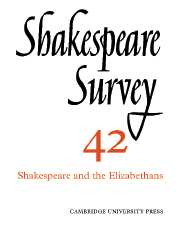Book contents
- Frontmatter
- ‘Jack hath not Jill’: Failed Courtship in Lyly and Shakespeare
- Truth and Art in History Plays
- Chronicles and Mythmaking in Shakespeare’s Joan of Arc
- King John and Embarrassing Women
- Golding’s Ovid, Shakespeare’s ‘Small Latin’, and the Real Object of Mockery in ‘Pyramus and Thisbe’
- Ovid and the Sonnets; or, did Shakespeare Feel the Anxiety of Influence?
- The Play of Sir Thomas More and Some Contemporary Events
- ‘Nobody’s Perfect’: Actors’ Memories and Shakespeare’s Plays of the 1590s
- The Boyhood of Shakespeare’s Heroines
- Shakespeare’s ‘Brawl Ridiculous’
- Shakespeare’s Handwriting
- Shakespeare Performances in England, 1987–8
- Professional Shakespeare Productions in the British Isles, January-December 1987
- The Year's Contributions to Shakespearian Study 1 Critical Studies
- 2 Shakespeare’s Life, Times, and Stage
- 3 Editions and Textual Studies
- Books Received
- Index
3 - Editions and Textual Studies
Published online by Cambridge University Press: 28 March 2007
- Frontmatter
- ‘Jack hath not Jill’: Failed Courtship in Lyly and Shakespeare
- Truth and Art in History Plays
- Chronicles and Mythmaking in Shakespeare’s Joan of Arc
- King John and Embarrassing Women
- Golding’s Ovid, Shakespeare’s ‘Small Latin’, and the Real Object of Mockery in ‘Pyramus and Thisbe’
- Ovid and the Sonnets; or, did Shakespeare Feel the Anxiety of Influence?
- The Play of Sir Thomas More and Some Contemporary Events
- ‘Nobody’s Perfect’: Actors’ Memories and Shakespeare’s Plays of the 1590s
- The Boyhood of Shakespeare’s Heroines
- Shakespeare’s ‘Brawl Ridiculous’
- Shakespeare’s Handwriting
- Shakespeare Performances in England, 1987–8
- Professional Shakespeare Productions in the British Isles, January-December 1987
- The Year's Contributions to Shakespearian Study 1 Critical Studies
- 2 Shakespeare’s Life, Times, and Stage
- 3 Editions and Textual Studies
- Books Received
- Index
Summary
Far from transcending farce, as critics have claimed, The Comedy of Errors ‘uses farce to achieve ends that are proper to farce – surprise, suspense, laughter’; in this play characters ‘do not so much relate as collide with one another’. Patrick Swinden’s no-nonsense account remains true to one’s experience of the play in performance: the hectic pace of the complicated plot ensures that its puppets have about as much psychological and emotional reality as Keystone Cops. It seemed wholly apt that in the BBC TV production Egeon’s long opening tale of woe – in which a delightfully improbable series of coincidences and mishaps serves to set up the situation for the delightfully improbable confusions that follow – was comically mimed by a troupe of street-theatre harlequins, and drew histrionic sniffles and tears from the listening Ephesians.
T. S. Dorsch, editor of the New Cambridge Comedy of Errors, takes the more common view that 'we must... feel deeply for Egeon as he tells his woeful story' (p. 14). He sees the play as 'a finely-balanced mixture of pathos and suspense, illusion and delusion, love turned bitter and love that is sweet, farce and fun' (p. 12), and briefly expands this description in the kind of old-fashioned character analysis that worries away at the differences in the dispositions of Dromio of Ephesus and his Syracusan twin. It is true, of course, that the play incorporates Adriana's jealousy, the wooing of her sister Luciana by Antipholus of Syracuse, and the hurt perplexity of Egeon in the closing scene before the joyous family reunion.
- Type
- Chapter
- Information
- Shakespeare Survey , pp. 200 - 214Publisher: Cambridge University PressPrint publication year: 1990

